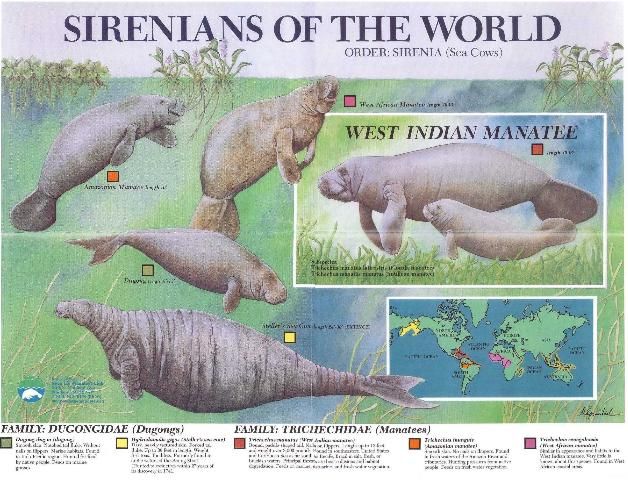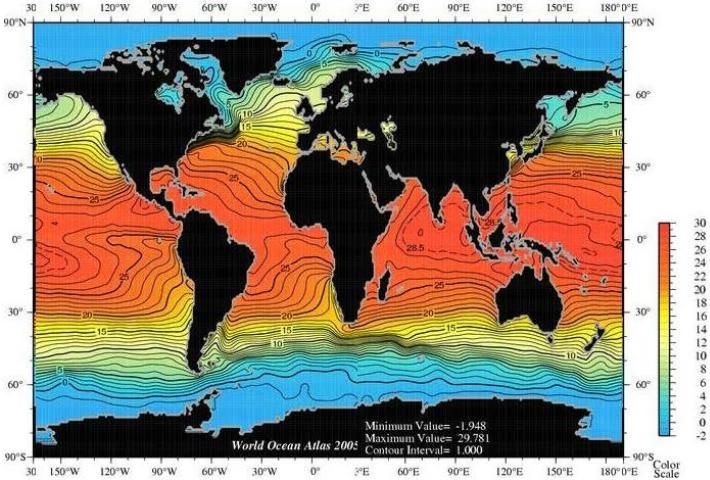For more lessons in the Third Grade Manatee Curriculum series, go to http://edis.ifas.ufl.edu/topic_series_third_grade_manatee_workbook.
Description
Students will learn about different species of sirenians and will use maps to locate where each species lives in relation to the continents and the temperature of the water.
Objective
By the end of the activity, students will be able to name at least three different types of sirenians and where they live.
Standards Addressed
Florida—SC.3.N.1.1;
Common Core—CCSS.ELA-Literacy.RI.3.7; CCSS.Math.Content.3.NF.A.1
Vocabulary
extinct, sirenian, blubber, species, continent
You Will Need
- Copies of Florida Fish & Wildlife Conservation Commission's Manatee Activity Workbook—Florida's Gentle Giants for each student, or copies of Sirenia distribution map
- Copies of Sirenia species image ("Sirenians of the World" poster, included with this activity) for small-group use
- Rulers
- Map of sea surface temperatures (included with this activity)
- Copy of world map worksheet and Lesson 5 (Sirenians) worksheet for each student
Strategy
- Explain to students that the manatees in Florida are one of five species that belong to a group of animals called Sirenia. This lesson will teach them about the different Sirenian species. Have students look at page 6 ("Sirenians of the World" section) in the activity book Florida's Gentle Giants.
- Explain that Florida manatees don't have much blubber (fat), but one of their relatives did—the Steller's Sea Cow. It lived in the Bering Sea, off Alaska, but is now extinct. It was hunted for its blubber, which people burned for light and heat (a bit like candle wax). People discovered Steller's Sea Cows in 1741, but by 1768 they were extinct (which means there were no more living). (See blubber glove activity in Lesson 9.)
- Show students the drawing of the different sirenian species (via laminated handouts or projector). Ask them to write on their worksheet which species is the largest. (Answer: Steller's Sea Cow)
- Show students the map of sea surface temperatures. Explain to them that the water temperatures are given in degrees Celsius, and show them how to use the table to find the equivalent temperatures in Fahrenheit. Have them use the temperature map and the "Sirenians of the World" map (on page 6 of Florida's Gentle Giants activity book) to answer questions on the Lesson 5 (Sirenians) worksheet.
- Pose a hypothesis: Animals that live in warmer water often grow faster, but don't get as big as animals that live in colder water. Do the students' observations about Sirenian species agree with this statement?
- Give students a world map worksheet (such as http://www.enchantedlearning.com/geography/label/labelcontinents.shtml). Have them label the continents. Which continents do not have any manatees or manatee relatives? (Answer: Europe, Antarctica.) What fraction of the continents has manatees or manatee relatives? (Answer: 5/7)

Credit: Save the Manatee Club (http://www.savethemanatee.org)

Credit: NOAA/National Ocean Climate Data Center
Lesson 5 (Sirenians) Worksheet
Name: ________________________________
-
Which of the sirenians is the largest? _________________________
-
Look at the "Sirenians of the World" map on page 6 of the Florida's Gentle Giants activity book. There are different patterns on the map showing where the different types of sirenians live. Use the map to answer the following questions:
a. In what sea did the Steller's sea cow live? ________________
b. The dugong can be found on the edges of three continents. Name one of those continents: _________________________
3. Look at the temperature map side-by-side with the "Sirenians of the World" map. We're going to compare the ocean temperatures with where the different sirenians can be found. To do this, look for the lines on the temperature map that have the number 20 written in them. Now, try and draw these lines on the "Sirenians of the World" map by looking for the points where the 20°C lines meet the continents and then marking those points on the "Sirenians of the World" map. Then connect them with lines that are close to the same shape as the ones on the temperature map.
a. What types of sirenians are found between the 20°C lines? _________________________________________
b. What type of sirenian is found outside the 20°C lines (i.e., in water colder than 20°C)? ______________________________
Lesson 5 (Sirenians) Answer Key
-
Which of the sirenians is the largest? Steller's Sea Cow
-
Look at the "Sirenians of the World" map on page 6 of the Florida's Gentle Giants activity book. There are different patterns on the map showing where the different types of sirenians live. Use the map to answer the following questions:
a. In what sea did the Steller's sea cow live? Bering Sea
b. The dugong can be found on the edges of three continents. Name one of those continents: Australia, Asia, or Africa
3. Look at the temperature map side-by-side with the "Sirenians of the World" map. We're going to compare the ocean temperatures with where the different sirenians can be found. To do this, look for the lines on the temperature map that have the number 20 written in them. Now, try and draw these lines on the "Sirenians of the World" map by looking for the points where the 20°C lines meet the continents and then marking those points on the "Sirenians of the World" map. Then connect them with lines that are close to the same shape as the ones on the temperature map.
a. What types of sirenians are found between the 20°C lines? West Indian Manatee, Amazonian Manatee, West African Manatee, Dugong
b. What type of sirenian is found outside the 20°C lines (i.e., in water colder than 20°C)? Steller's Sea Cow